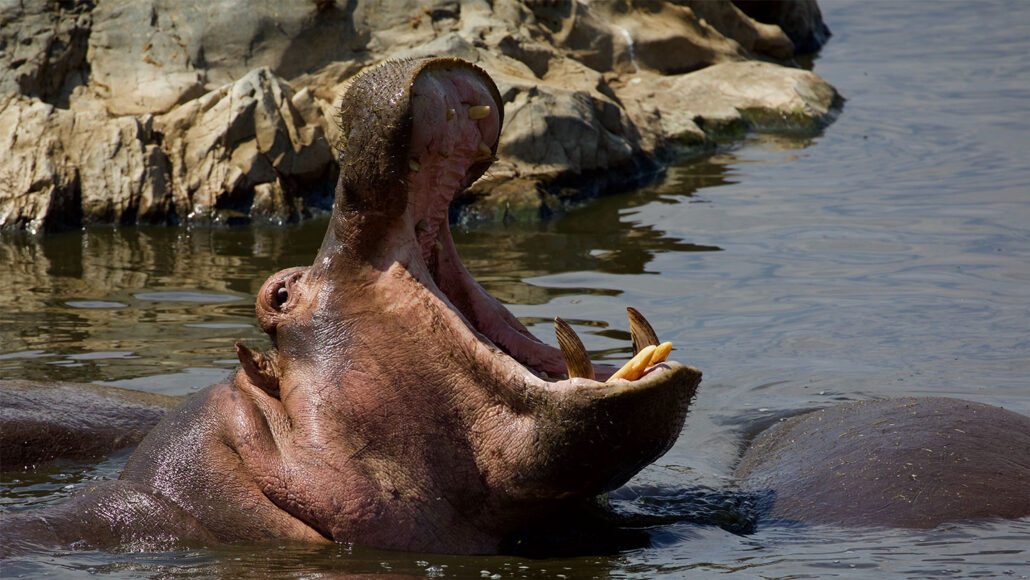The Formidable Battle Skills of Hippos are Hindering Their Chewing Ability

Hippos are horrible at chewing, and their giant tusks and front teeth are to blame.
These intimidating dental features are used by hippos, in part, to protect themselves and their territory. But some of the gnarly teeth interlock or hinder jaw movements, preventing hippos from efficiently chewing with the side-to-side grinding technique that other herbivores use, researchers report October 4 in PLOS ONE.
Plant-eating mammals typically use the broad teeth near the sides of their mouths to grind and shred fibrous vegetation before swallowing it. Since their digestion process barely reduces food particle size, you can gauge chewing efficiency by looking at their feces.
In 2009, veterinarian Marcus Clauss of the University of Zurich and his colleagues compared the sizes of fecal particles across nearly 200 mammal species. They found that hippos were the least effective chewers among herbivores. Years later, he and his colleague Annika Avedik wondered whether hippos’ enormous front teeth were the cause of their meager munching.
Some herbivores, such as deer and cattle, have lost some of their front incisors during evolution, possibly because they impeded chewing. African rhinos have lost theirs entirely. “Hippos are a case example of a taxon that did not lose them,” Clauss says.
The researchers analyzed videos of common (Hippopotamus amphibius) and pygmy hippopotamuses (Choeropsis liberiensis) eating, closely tracking how the teeth interacted as the jaws moved. The team also measured physical features of 86 common hippo and 21 pygmy hippo skulls in museum collections, including the spacing and arrangement of the teeth, and tested the side-to-side jaw range of these skulls and measured places where the teeth wore on each other.
Clauss had originally thought that common hippos’ huge tusks, which are modified canine teeth, would be what stopped the animals from proper side-to-side chewing. “Boy, was I wrong,” he says.
Instead, the team found that common hippos’ upper and lower sets of long, spearlike incisors cross and interlock as the lower jaw closes, restricting the back teeth to up-and-down mashing. The herbivores still try some side-to-side movement of the jaw, Clauss says, evidenced by wear marks on the sides of the incisors.
Pygmy hippos’ incisors don’t interlock, but their tusks bump up against the snout, allowing only a limited amount of side sliding. Wear patterns show that the incisors glide past each other when chewing.
Because pygmy hippos show some side-to-side jaw movement when chewing, it hints that “lateral grinding chewing is something [hippos] once did, and that it got lost along the way,” Clauss says.
Hippos now use their rigid jaws, wide gapes and sharp, sturdy tusks and incisors, in part, to combat other hippos over territory and access to mates, and to defend against predators. But the potential shift to less efficient chewing could have come with consequences. Because hippos can’t mulch food into very small pieces, it takes longer for it to be digested, Clauss says.
“If food has to stay longer in the gut, it means one cannot eat more, quickly. Hence hippos are, among mammalian herbivores, characterized by relatively low food intakes,” he explains.
Their comparatively low food intake may put hippos at a competitive disadvantage against other, more efficiently chewing ruminant herbivores such as antelope. An inability to compete with fully land-dwelling species for sufficient food may keep hippos wedded to the African waterways the semiaquatic animals call home.
The study is “a really good reminder of the complexity of organisms, and that when anatomical parts, such as teeth, are viewed in isolation, they may not explain the whole picture,” says comparative biomechanist Susan Williams of Ohio University in Athens.
Studying fossil hippo ancestors could reveal if, and when, hippos’ side-to-side motion during chewing stopped, rounding out understanding of the animals’ evolutionary story. Juvenile hippos also don’t yet have incisors large enough to interlock, so Clauss is curious to see if these youngsters temporarily use side-to-side chewing.
Our mission is to provide accurate, engaging news of science to the public. That mission has never been more important than it is today.
As a nonprofit news organization, we cannot do it without you.
Your support enables us to keep our content free and accessible to the next generation of scientists and engineers. Invest in quality science journalism by donating today.




